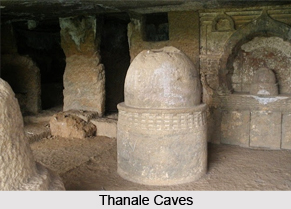 The rock-cut Buddhist temples of Thanale Caves in Maharashtra, contain 28 rock-cut caves of the ancient period that approximately dates back to 1st - 3rd Century AD. The paintings in Thanale Caves are an extraordinary accomplishment of art. Thanale Caves are situated in the trade centre, near Chaul, an ancient port. There are remains of Indian cave paintings in Cave 13 that can be traced back to 5th century AD.
The rock-cut Buddhist temples of Thanale Caves in Maharashtra, contain 28 rock-cut caves of the ancient period that approximately dates back to 1st - 3rd Century AD. The paintings in Thanale Caves are an extraordinary accomplishment of art. Thanale Caves are situated in the trade centre, near Chaul, an ancient port. There are remains of Indian cave paintings in Cave 13 that can be traced back to 5th century AD.
History of Thanale Caves
The Thanale Caves are amongst the most significant rock-cut temples in India and is placed near the mountain pass, where the trade route lies. Coins from the period of Emperor Ashoka have been obtained in this site. Thus it is estimated that the caves were created during the 3rd century BC. The caves were considered quite important during the ancient period. The caves were discarded around 5th century AD, after the decline of Chaul port.
The caves were noticed by J. A. Abnot, a missionary, in 1890. Vasudeo Balwant Phadke, the renowned revolutionary, utilised the caves for shelter and refuge. The appearances of visitors, who are attracted by the natural beauty of the location, have contributed to the defilement and damage of the valuable artworks and sculptures of ancient India.
Details of Thanale Caves
Amidst the stunning natural beauty and the stunning landscape of the region, lies the ancient rock cut temples of Thanale. The caves are situated in the base of the gigantic cliff and are set in a row. The caves have suffered damages due to natural factors, like the damage the front wall and the collapse of the ceilings of few caves.
There are a total of 28 caves in the region embellished by stone carved sculptures above the gateways and up on the ceilings, including a statuette of Naga, lord of the serpents. There are around 13 stupas in Cave 3. Cave 13 consists of remains of plastered on the side walls of the caves that include traces of painting. It is estimated that the paintings were made around 5 century AD. Shades of red, white, blue and yellow were mainly used by the artists. There are also numerous cells cut in rock that are present in the caves.




